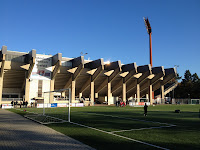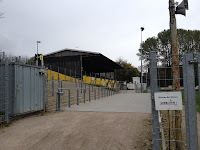Düsseldorfer Turn- und Sportverein Fortuna 1895 e.V. to give Fortuna Düsseldorf their full title, are a football club from the industrial city of Düsseldorf in Germany's North Rhine-Westphalia region. The club were formed as part of the Turnverein Flingern gymnastics club in 1895, with the team moving to play home games at Lichtplatz from 1908.
Two other local clubs; Düsseldorfer Fußballklub Spielverein who were founded in 1908, and Fortuna (earlier FK Alemania) who were formed in 1911 amalgamated to form Düsseldorfer Fußball-Club Fortuna 1911 in 1913. Another club, TV Flingern joined forces to create Düsseldorfer Turn- und Sportverein Fortuna on 15 November 1919 as the club moved to a new home ground at Vennhauser Straße.
| Outside the Espirit Arena |
In the 1920's Fortuna began to win honours, picking up four Bezirksliga district titles and providing their first German international player; Ernst Albrecht. In 1930 the club moved grounds once again, this time to Flinger Broich or Fortunaplatz as it was otherwise called in the Flingern district of the city. In 1933 the club were crowned as German champions after winning the national championships and defeating the prominent Schalke 04 in the final in Cologne.
During the period in which the Third Reich were in power, Fortuna were placed in Gauliga Niederrhein, one of sixteen top tier divisions. They were dominant at this level, lifting the title five times as well as being defeated in the national final of 1936 and reaching the Tschammerpokal, which was the predecessor of the DFB Pokal, the following year. The stand out player of that period was Paul Janes, who was the record appearance holder for Germany until 1970.
| Paul Janes Stadion |
In 1970 Fortuna returned Fortunaplatz for a couple of seasons while the Rheinstadion was rebuilt, as well as winning promotion to the top flight in 1971, for a spell that lasted sixteen years. Third place finished came in the 1972/73 and 1973/74 seasons. The team reached another Pokal in 1978, this time losing to local rivals 1.FC Koln. On the 9th December 1978 Fortuna hammered Bayern Munich 7-1 at the Rheinstadion.
To see Bayern's largest Bundesliga's defeat, go to: http://www.youtube.com/watch?v=Q2AU43uHtn8
 |
| The Rheinstadion in its prime |
To see the final, click on: http://www.youtube.com/watch?v=iQ7bOOMWzU0
Fortuna were relegated in 1987, but they retiurned two years later for a spell of five seasons. They fought back once again to regain their top tier place between 1995 and 1997, before the club entered a period of turmoil. By 2002 Fortuna found themselves in the fourth tier Oberliga Nordrhein and in huge financial trouble, while playing at the Paul Janes Stadion as Fortunaplatz had been re-named from 1990 in honour of their former hero. The stadium also housed Fortuna Düsseldorf II. Local punk band Die Toten Hosen helped out by sponsoring the club for a few seasons.
 |
| Inside the Espirit Arena |
In 2005 Fortuna returned to the site where the new LTU Arena stood in place of the demolished Rheinstadion. In 2008 the club played in the newly formed 3.Bundesliga where they finished as runners-up and won promotion. The 2009-10 season saw the team narrowly miss out on another promotion after finishing in fourth place at the re-named Espirit Arena. After an average following campaign Fortuna started the 2011-12 season in great form, as they headed the table for some time. They eventually won promotion back to the 1.Bundesliga via a play off win over Hertha BSC Berlin. Team captain Andreas Lambertz became the first German player to be promoted three times with the same club.
However, the spell in the top flight lasted just one season as Fortuna were relegated on the final day of the 2012-13 season after defeat to Hannover 96.
Fortuna Dusseldorf will play in 2. Bundesliga in the 2013-14 season.
My visit
Fortuna Düsseldorf 1 Bayern München 2 (Saturday 14th October 1989) 1.Bundesliga (att: 55,000)
I was on my first ever trip outside the UK with some pals from the Gas Club in Scarborough on a mini holiday in the Rhine Valley. We arrived in Germany on the Friday afternoon, with the coach stopping for an hour or so in Bonn for our driver Derek, to have his designated rest. Naturally enough, without further ado, we headed for a bar.
The establishment we chose had various football mementos hanging up. We managed to get through to the barman that we wanted to know the fixtures for the following day, with this been in the days before the internet and the same coverage that would later be taken as normal. It was established that the game that stood out was Düsseldorf v Munich, with Scottish international Alan McInally getting great reviews back home while starring for Bayern.
I went drinking on the Friday evening with Crusher and Kev Phillips before meeting up with the rest of the gang. Both were very keen on going to the game, so we agreed to make sure we got up and had breakfast to set us on our way. Derek, who wasn't exactly endearing us gave us the advice that we needed to travel south and across the river to Rüdesheim. This needed a costly taxi ride, but we took what he said as gospel. After a couple of liveners at the bar next to the station we got on board our train, only to find out it went via Koblenz, where Derek was taking the rest of the party on a shopping trip!
We arrived a train that got busier with fans as we approached Düsseldorf after our ride that lasted over three hours. We got a few looks as we spoke in English, but the locals were fine once they realised that we weren't Bayern fans. We followed the crowds downstairs to the trams and we were quickly on a packed service to the Rheinstadion.
We managed to work out that we needed tickets in advance, but that was no obstacle. Despite the high attendance, the stadium held 76,000 at the time. We went inside and found ourselves on the terracing behind the goal for 12DM, which was around £4 at the time.
The Rheinstadion was a beautiful venue, although not perfect for football as the pitch was surrounded by an athletics track that had hosted the 1977 World Championships. There was a continuous lower tier with terracing at each end. Above of this tier was a horseshoe shaped upper level, with the far end open. Seating occupied upstairs apart from a couple of blocks at the far end, where the Fortuna fans stood.
Bayern began the game well on top and went ahead after just five minutes through Manfred Schwabl. Much though we were urging on the home side, they doubled their lead on thirty two minutes when Roland Wohlfarth netted.
 |
| Me and my new friend |
Fortuna battled back after the break, but couldn't get a goal back immediately. We wanted to hear the noise if they did. On the hour they did get back into the game via a Klaus Augenthaler own goal. Despite the efforts of Uwe Fuchs leading the home forward line, Bayern held out reasonably comfortably to pick up an away victory.
We let the crowd drift away as we bought a bratwurst and a alcohol free beer and sat in the upper tier seats to get a better view. This allowed us to get on a tram hassle free and even get a seat. We were advised that it was best for us to change trains at Cologne on the way back by the man at the Hauptbanhof. While we were waiting for it to come along a special train full of Bayern fans went past us. I was wearing a Fortuna hat, and received dogs abuse, much to the hilarity of my pals.

We did change at Cologne, and lo and behold we caught a direct train to St Goar, where we were based. A couple of hours later we were sat in the pub having a meal and watching the highlights while drinking away. It was as well Derek didn't feel thirsty, as we ready to offer him major feedback!
The pictures at the top of this page of The Espirit Arena, Rheinstadion and Paul Janes Stadion have been taken from the internet. They will be replaced, hopefully soon, when I return for a game.












































